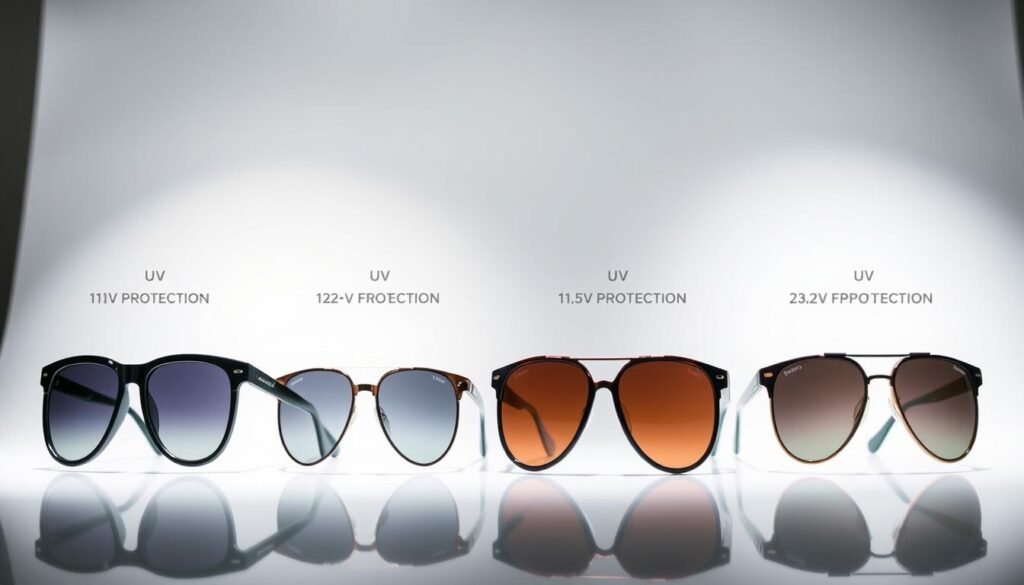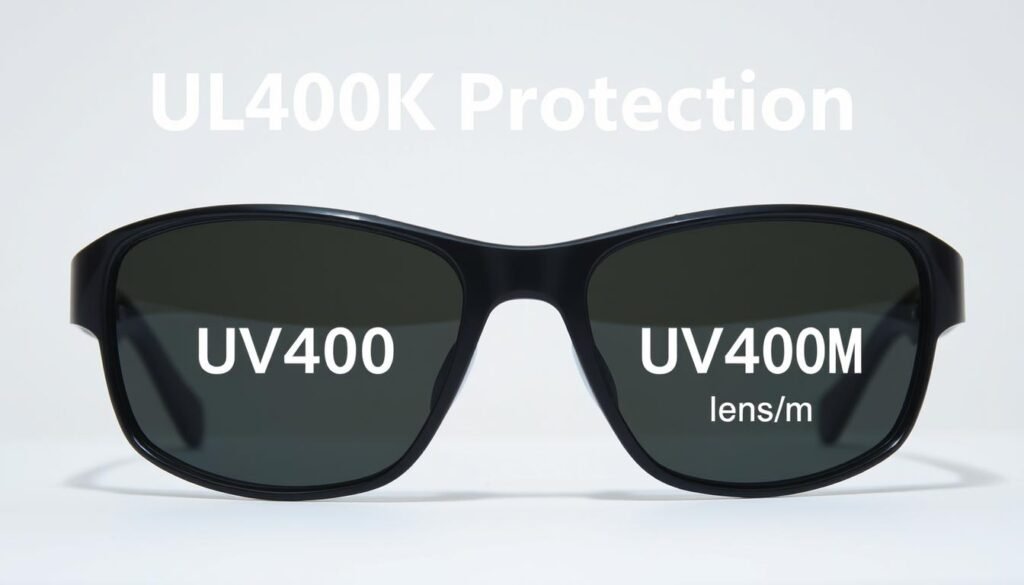Sunlight brings warmth and joy, but its invisible ultraviolet rays pose risks to one of our most vital senses: vision. Not all shades offer equal defense against these harmful wavelengths. The difference between basic and advanced options lies in technical specifications that directly impact long-term eye health.
Experts agree that UV 400 represents the benchmark for safeguarding eyes. This rating blocks wavelengths up to 400 nanometers, filtering out nearly all UVA and UVB radiation. The American Academy of Ophthalmology stresses that 99-100% blockage isn’t just ideal—it’s essential for preventing cumulative damage that could lead to cataracts or macular degeneration.
Quality lenses do more than darken your view. They screen 75-90% of visible sunlight while maintaining color accuracy and clarity. Prioritizing this level of coverage ensures you’re not just buying style, but investing in durable defenses against solar threats that intensify with prolonged exposure.
Key Takeaways
- UV 400-rated lenses provide near-complete blockage of harmful ultraviolet rays
- Medical professionals recommend blocking 99-100% of UVA/UVB radiation
- Effective eyewear filters both invisible UV and excessive visible light
- Long-term eye health depends on consistent protection from solar exposure
- Quality matters more than darkness when choosing protective lenses
Understanding UV Protection: What Does UV400 Mean?
Not all light is created equal—some wavelengths carry hidden risks. UV400 refers to lenses that filter wavelengths up to 400 nanometers, acting like an invisible shield against solar radiation. This standard covers the full spectrum of damaging rays, including both UVA and UVB types.
The Science Behind UV Ratings
Ultraviolet radiation exists just beyond visible light. Measured in nanometers, these rays split into three types:
| Ray Type | Wavelength Range | Primary Target | Health Impact |
|---|---|---|---|
| UVA | 315-400 nm | Macula | Central vision loss |
| UVB | 280-315 nm | Lens | Cataract risk |
Both types penetrate Earth’s atmosphere daily. Clouds reduce visible brightness but don’t stop ultraviolet penetration. This explains why eye protection remains crucial regardless of weather conditions.
How UV400 Lenses Work to Block Harmful Rays
Advanced lenses use layered filtering technology. Special coatings absorb or reflect dangerous wavelengths while allowing safe visible light through. The 400 nm threshold specifically blocks:
- 100% of UVB rays
- 99% of UVA rays
- High-energy visible (HEV) blue light
This triple defense system prevents cumulative damage. By stopping harmful energy at the lens surface, it preserves long-term eye health without distorting colors or clarity.
The Impact of UV Exposure on Eye Health
While sunlight fuels life on Earth, its unseen ultraviolet components wage a silent war against our vision. The World Health Organization reports UV radiation contributes to 20% of cataract cases globally. More alarmingly, this damage accumulates like invisible debt—each sunny day without protection adds interest to your ocular health bill.
UVA vs. UVB: Risks to Your Eyes
These two ultraviolet types attack different parts of your eyes. UVA rays penetrate deep into the macula, the retina’s central hub for sharp vision. UVB focuses on the lens, causing protein clumping that leads to cloudiness. Think of them as:
- UVA: Silent macula disruptors
- UVB: Lens-damaging aggressors
Children’s eyes absorb 70% more UV than adults’ due to clearer ocular lenses. This makes early protection critical—symptoms often surface decades later.
Long-Term Health Implications and Eye Conditions
Unchecked exposure doesn’t just risk cataracts. It’s linked to:
- Macular degeneration (leading cause of senior vision loss)
- Photokeratitis (painful corneal sunburn)
- Pterygium (tissue growth on the eye surface)
By age 18, most Americans have already absorbed half their lifetime UV dose. This delayed-effect pattern means today’s choices directly shape your visual future. Consistent shielding from youth onward remains the best defense against these stealthy threats.
How to Verify That Your Sunglasses Have the Highest UV Protection
Many assume darker lenses mean better defense, but that’s a dangerous misconception. True solar shielding has nothing to do with lens color or tint intensity. Those amber lenses you love? They might offer less protection than lightly tinted ones with proper coatings.

Testing Your Lenses for UV Absorption
Optical stores use specialized photometers to measure ultraviolet blockage. These devices reveal what human eyes can’t detect:
- Invisible protective coatings
- Actual percentage of blocked rays
- Potential coating degradation
Most eye care centers provide free testing—simply bring your favorite pair. Professionals recommend checking older eyewear annually, as scratches and wear can reduce effectiveness.
When shopping for new lenses, prioritize labels over looks. Trustworthy brands clearly state:
- “100% UV absorption”
- “UV400 protection”
- Compliance with ANSI Z80.3 standards
“Lens darkness only affects visible light, not ultraviolet filtration. Protection comes from materials, not tint density.”
Remember: quality coatings feel smooth, not sticky. Pressured sales tactics claiming “extra dark means extra safe” often signal red flags. Stick to verified retailers and documented protection levels for peace of mind.
Comparing UV Protection Categories: Which Lens is Right for You?
Choosing eyewear isn’t just about blocking glare—it’s about matching lens technology to your environment. Five distinct protection levels exist, each designed for specific light conditions and activities. Let’s explore how these categories align with real-world needs.

Category 3 vs. Category 4: When and Where to Use Them
| Feature | Category 3 | Category 4 |
|---|---|---|
| UV Blockage | 82-92% | 92-97% |
| Light Conditions | Bright urban areas | Glacial/desert terrain |
| Common Uses | Beach days, driving | Mountain climbing, sailing |
| Legal for Driving? | Yes | No |
Category 3 lenses serve most daily needs perfectly. They reduce glare during city commutes or summer picnics without overly darkening your view. Think of them as your go-to pair for typical sunny days.
Category 4 becomes essential when reflections multiply UV intensity. Snowfields reflect 80% of sunlight compared to 15% from grass. This makes them vital for alpine hiking or tropical boating—but always pack alternate eyewear for the drive home.
Finding Your Functional Fashion
Modern protective eyewear comes in wraparound sports frames and classic aviators. Mirrored coatings and gradient tints prove safety doesn’t sacrifice style. Opt for polarized options if water sports or winter activities dominate your calendar.
“Your eyewear should match your adventure scale—both in coverage and comfort.”
Remember: lens darkness indicates visible light filtration, not UV blocking power. A pale amber lens with proper coatings often outperforms dark generic shades. Always check for documented 100% protection claims before purchasing.
Enhancing UV Protection with Advanced Lens Features
Modern eyewear combines multiple technologies to combat solar threats effectively. While UV blockage forms the foundation, specialized features address specific environmental challenges and activity demands.
The Role of Polarized Lenses in Reducing Glare
Polarized lenses act like microscopic blinds for your eyes. Their vertical filter pattern cancels horizontal light waves bouncing off flat surfaces like water or snow. This eliminates blinding glare during fishing trips or ski adventures.
Important note: polarization ≠ UV protection. Many budget options skip proper coatings. Always verify both features exist in your eyewear. As one optical engineer states:
“Think of polarization as glare management and UV400 as health insurance – you need both for complete defense.”
Additional Coatings and Their Benefits
Premium lenses stack protective layers like armor:
- Anti-reflective: Minimizes internal glare from behind
- Mirror: Bounces away excess light in bright conditions
- Scratch-resistant: Maintains clarity through rough use
Polycarbonate material naturally blocks UVB rays while staying feather-light. Pair these lenses with wraparound frames, and you create a fortress against angled sunlight. The best designs feel so comfortable you’ll forget they’re working overtime to protect your vision.
Conclusion
Guarding your vision goes beyond fashion trends. UV400-certified eyewear blocks 99-100% of damaging rays, meeting rigorous standards set by eye health experts. This technology acts as your first defense against solar energy that penetrates cloud cover and reflects off surfaces year-round.
Damage from daily exposure compounds silently over decades. Consistent use of properly rated lenses helps prevent irreversible conditions like macular degeneration—the leading cause of severe vision loss in older adults. Think of quality eyewear as essential health gear, not just seasonal accessories.
When selecting your next pair, prioritize documented protection levels over price tags or frame designs. Visit an optical professional to test existing lenses’ effectiveness using specialized equipment. Many discover their favorite shades fall short of true safety benchmarks.
Your eyes’ long-term wellness depends on informed choices today. By embracing verified UV400 options, you’re not just accessorizing—you’re preserving one of life’s most precious senses through every sunrise and sunset.

